Zoom
Trash

Spotlight 5- Infinite Connections.pdf. Tres categorías de aplicaciones para la gestión y el control de tabletas en el aula. La introducción de las tabletas en el aula introduce nuevos retos técnicos para un aprendizaje fluido.
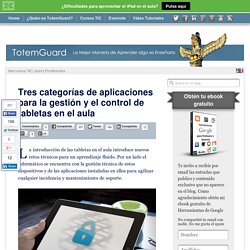
Por un lado el informático se encuentra con la gestión técnica de estos dispositivos y de las aplicaciones instaladas en ellos para agilizar cualquier incidencia y mantenimiento de soporte. Foto por cortesía de ©Placeit.net Por otro lado igualmente el profesor necesita aprender cómo puede interactuar con los alumnos a través de estas tabletas para ofrecer lecciones de aprendizaje efectivas y además poder controlar y guiar a la clase cuando surgen dudas y problemas. El sistema cerrado de los dispositivos iOS y la gran variedad de hardware en dispositivos Android ponen limitaciones y dificultades en el desarrollo de aplicaciones para tabletas que permitan funcionalidades completas de gestión y control de aula que ya se utilizaban con ordenadores Windows, Linux y MAC.
Digital Framework. 5 Tips for Classroom Management With Mobile Devices. When adopting technology in the classroom, one of the key concerns for teachers and administrators is classroom management.

I am often asked if there is a way to “lock down an iPad screen” or “ensure students cannot go to inappropriate websites” (e.g. Social Media). In other words, how do we keep students on task and are not distracted by the novelty of gadgets or communicating with friends via texting or social media. Often, teachers will take up devices (such as mobile phones) to avoid the issue of students texting or checking Facebook on their phones (eliminating access to a powerful, pocket computer in the process). Classroom management is a challenging skill which I consistently strive to improve on a regular basis. Establish Clear Expectations Just as I start out the school year with “Class Rules” that we make and agree to as a group, we also establish expectations for when we use technology. Let them “Get the Giggles Out” Engagement is Key Two Eyes, Two Feet.
12 Principles Of Mobile Learning. 12 Principles Of Mobile Learning by Terry Heick Ed note: This post has been updated and republished from a 2012 post Mobile Learning is about self-actuated personalization.
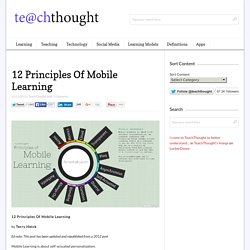
As learning practices and technology tools change, mobile learning itself will continue to evolve. For 2016, the focus is on a variety of challenges, from how learners access content to how the idea of a “curriculum” is defined. It is only within these communities that the native context of each learner can be fully understood. Mobile gives the edge. 5 Visions about Future of Mobile Learning. 50 Reasons It's Time For Smartphones In Every Classroom. 50 Reasons It’s Time For Smartphones In Every Classroom by Terry Heick There are many ways to use a smartphone in the classroom, but it continues to be a touchy subject.
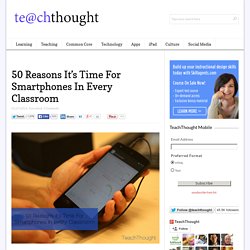
Privacy, equity, bandwidth, lesson design, classroom management, theft, bullying, and scores of other legitimate concerns continue to cloud education’s thinking about how to meaningfully integrate technology in the learning process. To be clear–learning can happen in the absence of technology. Integrated poorly, technology can subdue, distract, stifle, and obscure the kind of personal interactions between learner, content, peer, and performance that lead to learning results. But increasingly we live in a world where technology is deeply embedded into everything we do.
There will be growing pains, and I’m sure educators that have brought in BYOD programs into their school can come up with 50 reasons it won’t work. Which will make an iPhone or Nexus 5 look like an abacus. 1. 2. 3. 4. 5. 6. 7. 8. 9. Tablets_in_your_school.pdf. Mobile Learning Publications. UNESCO Mobile Learning Publications Today there are over six billion mobile phone subscriptions worldwide, and for every one person who accesses the internet from a computer two do so from a mobile device.

Given the ubiquity and rapidly expanding functionality of mobile technologies, UNESCO is enthusiastic about their potential to improve and facilitate learning, particularly in communities where educational opportunities are scarce. This Working Paper Series scans the globe to illuminate the ways in which mobile technologies can be used to support the United Nations Education for All Goals; respond to the challenges of particular educational contexts; supplement and enrich formal schooling; and make learning more accessible, equitable, personalized and flexible for students everywhere.
What is the future of mobile learning in education? The PDF file you selected should load here if your Web browser has a PDF reader plug-in installed (for example, a recent version of Adobe Acrobat Reader).
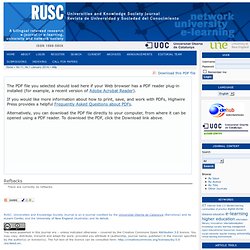
If you would like more information about how to print, save, and work with PDFs, Highwire Press provides a helpful Frequently Asked Questions about PDFs. Alternatively, you can download the PDF file directly to your computer, from where it can be opened using a PDF reader. To download the PDF, click the Download link above. Fullscreen Fullscreen Off Refbacks There are currently no refbacks. RUSC. The texts published in this journal are – unless indicated otherwise – covered by the Creative Commons Spain Attribution 3.0 licence. Grupo de trabajo de M-learning en Aulablog. Ene 15, 2013 Proyecto Waves Leer más ene 11, 2013 Historias en Stopmotion.
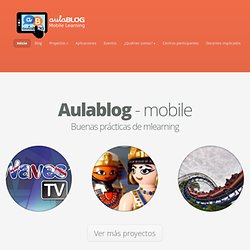
Designing mobile learning experiences that walk the talk. El uso del móvil para el aprendizaje. M-Learning. Home m-Learning Using tablets, smartphones and apps Welcome to mobile learning from Oxford ELT where you'll find lots of ideas for making the most of tablets, smartphones and apps in your teaching.

This page is for anyone who wants to find out more: You want to encourage your students to use smartphones for learning, rather than as a distraction.You have 'gone digital' and now only use tablets, smartphones and computers.You'd like to put forward a proposal to your Director to use mobile devices.You want to find out how to motivate your students, and wonder if m-learning might help. Resources White Paper Download our free white paper for support, guidance and best practice ideas on implementing tablets in teaching and learning.
Written by Diana Bannister MBE, Development Director for Learning Technologies at the University of Wolverhampton, and Shaun Wilden, Teacher Training Coordinator at International House World Organisation. From the blog Webinar recordings. Universal instructional design principles for mobile learning.